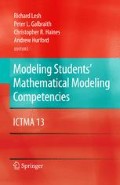Abstract
At ICTMA-13, where the chapters in this book were first presented, a variety of views were expressed about an appropriate definition of the term model – and about appropriate ways to think about the nature of modeling activities. So, it is not surprising that some participants would consider this lack of consensus to be a priority problem that should be solved by a research community that claims to be investigating models and modeling
Access this chapter
Tax calculation will be finalised at checkout
Purchases are for personal use only
Notes
- 1.
When we speak of these dimensions of development, we recognize that, in specific “real life” situations where model development is needed, the most useful model is not necessarily the one that is most complex, most formal, most abstract, or most decontextualized.
References
Lesh, R., and Doerr, H. (2003). Beyond Constructivist: A Models & Modeling Perspective on Mathematics Teaching, Learning, and Problems Solving. In H. Doerr, and R. Lesh (Eds.), Hillsdale, NJ: Lawrence Erlbaum Associates.
Sawyer, R. K. (2006). Explaining Creativity: The Science of Human Innovation. New York: Oxford University Press.
Zawojewski, J., Diefes-Dux, H., and Bowman, K. (Eds.) (2009). Models and Modeling in Engineering Education: Designing Experiences for All Students. Rotterdam: Sense Publications.
Author information
Authors and Affiliations
Corresponding author
Editor information
Editors and Affiliations
Rights and permissions
Copyright information
© 2010 Springer Science+Business Media, LLC
About this chapter
Cite this chapter
Lesh, R., Fennewald, T. (2010). Introduction to Part I Modeling: What Is It? Why Do It?. In: Lesh, R., Galbraith, P., Haines, C., Hurford, A. (eds) Modeling Students' Mathematical Modeling Competencies. Springer, Boston, MA. https://doi.org/10.1007/978-1-4419-0561-1_2
Download citation
DOI: https://doi.org/10.1007/978-1-4419-0561-1_2
Published:
Publisher Name: Springer, Boston, MA
Print ISBN: 978-1-4419-0560-4
Online ISBN: 978-1-4419-0561-1
eBook Packages: Humanities, Social Sciences and LawEducation (R0)

